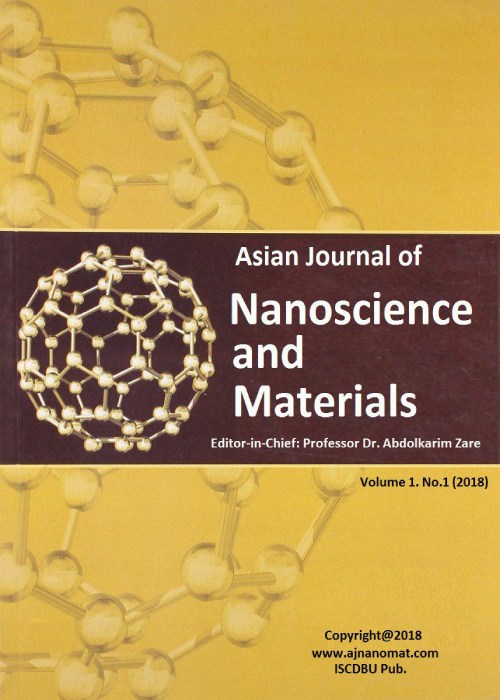فهرست مطالب

Asian Journal of Nanoscience and Materials
Volume:5 Issue: 3, Sep 2022
- تاریخ انتشار: 1401/06/10
- تعداد عناوین: 6
-
-
Pages 174-184In this work, silver nanoparticles were synthesized from silver nitrate using combretum micranthum leaves extract as a reducing and capping agent. The optical characterization through UV visible spectroscopy revelated a characteristic peak of surface plasmon resonance at 425 nm, while the particle size calculations based on the Mie diffusion theory indicated sizes ranging from 32.5 nm to 44.5 nm. The effects of different reaction parameters including the initial concentration of the precursor and the percentage of the leaves extract, were analyzed. The optimal conditions for the synthesis at room temperature are 0.5 g/L and 7.5 mM, respectively, for the plant extract's weight concentration and the precursor's initial concentration.Keywords: Combretum micranthum Green synthesis Mie theory Silver nanoparticles UV, Visible spectroscopy
-
Pages 185-195Bending instability is a significant reason for the success of the electrospinning process for decreasing the fiber’s diameter to nanometer scales and a determining factor in final fiber morphology. Observation of electrospinning of different polymers revealed that electrospun fibers accumulate in a circular area with various diameters in the case of a stationary flat plate target. There is an idea that the diameter of accumulated surface (ASD) is controlled by bending instability, and there is a correlation between electrospun fiber diameter and ASD. In this study, the accumulation behaviors of Polystyrene (PS), Polymethyl methacrylate (PMMA), and coaxially electrospun fibers of PS-PMMA were evaluated concerning their ASD sizes, the rate of ASD’s growth, and the correlation between ADS size and the final diameters. To determine the role of processing parameters on this behavior and the relationship between the ASD and final fiber diameter, some experiments were designed for three factors of voltage, flow rate, and tip to target distance for electrospun fiber diameters and ASD in PMMA electrospinning. Two polynomial equations were found (via regression). Then, the polynomial models statistically were analyzed and discussed. Scanning electron microscopy (SEM) and fluorescent microscopy were applied for morphological studies, and Image J were used for measuring the sizes. The results demonstrated that during the electrospinning, the ASD grew with the natural logarithm of time and so ended to a plateau (specific diameter), and after that, the upcoming electrospun fibers accumulated on the former ones. Moreover, bigger ASDs were accompanied by smaller electrospun fiber diameters.Keywords: Electrospinning, Jet Bending Instability, Desing of Experiments, Response Surface, statistical analysis
-
Pages 196-210In the current work, the density functional theory (DFT) and time-dependent density functional theory (TD-DFT) at ωB97XD/Lanl2DZ level of theory was accomplished to study the effects of Cu and Ni decorated on Boron nitride nanocage (B12N12) on the interaction of 8-hydroxyquinoline (8-HQ) drug as a novel candidate for drug delivery. The adsorption energy and thermodynamic results demonstrated that the adsorption of 8-HQ drug from O and N sites on the surface of nanocage was more favorable than other sites, and with decorating Cu and Ni atoms, the adsorption process of the 8-HQ drug was exothermic and spontaneous on the nanocage surface. The gap energy and global hardness values of the Ni and Cu decorated B12N12 nanocage was smaller than the pristine B12N12 nanocage, so the conductivity and reactivity of nanocage in this state was more than that the other states. The atom in molecule (AIM), reduced density gradient plots (RDG), and electron localized function (ELF) results confirmed that the nature of bonding between 8-HQ drugs with B12N12 nanocage was partially covalent or electrostatic. The UV-visible results revealed that with decorating Cu and Ni atoms, the optical properties of the system alter significantly from pure state. The results of this study can be used to make a novel sensitive sensor and novel drug delivery carriers for the 8-HQ drug.Keywords: B12N12 Cu, Ni decorated 8, HQ drug TD, DFT RDG
-
Pages 211-224Graphene oxide functionalized by ethane sulfonic acid (GO@ET-SO3H) is an efficient and environmentally benign catalyst for the synthesis of 1-[(1,3-thiazol-2-ylamino) methyl]-2-naphthols. The synthesis was implemented through a one-pot process by using no solvent by the reaction of 2-naphthol, functionalized benzaldehydes, and 2-aminothiazol. First, graphene oxide was prepared according to a modified Hummers method. It was subsequently modified by 2-Hydroxyethyl disulfide, and then oxidized with performic acid to reach the catalyst (GO@ET-SO3H). The catalyst was characterized by X-ray diffraction (XRD), energy-dispersive X-ray spectroscopy (EDS), field emission scanning electron microscopy (FE-SEM), thermogravimetric analysis (TGA), and FT-IR spectroscopy. The catalyst exhibited efficient properties such as simple work-up, no byproducts, sustainability, nonmetal and safe components, stability under reaction conditions, and recoverability.Keywords: Graphene oxide Ethane sulfonic acid catalyst Synthesis 2-Aminothiazole 1-[(1, 3-Thiazol-2-ylamino) methyl]-2-naphthols
-
Pages 225-233A magnesium aluminate catalyzed environmentally benign strategy for the synthesis of oxindole derivatives via the one-pot reaction between indole and isatin is established under reflux conditions in excellent yields. The reaction was carried out in ethanol and in the catalyst presence to give the corresponding oxindoles derivatives in high yields. The low cost, availability of catalyst, and the novel and green procedure makes this strategy more useful for the preparation of xanthene derivatives.Keywords: Multicomponent reactions (MCRs) Nano, Magnesium Aluminate Oxindole Derivatives One, Pot Synthesis Antimicrobial Agents
-
Pages 234-242The adsorption process of methyl green on the powder of silicon was investigated, parameters such as pH, time of mixing, dye concentration, temperature were studied. Data were tested for applicability of some isotherms like Langmuir, Freundlich, and Temkin. The adsorption data fitted well to these isotherms. The amount of adsorbate mono layer on silicon was 𝑞max =38.63988 mg/g. Hence, silicon powder could be used as economically and a green adsorbate fore methyl green dye from an aqueous solution.Keywords: Adsorption, Pollution, Silicon, Methyl green

